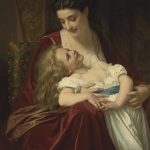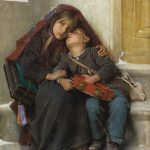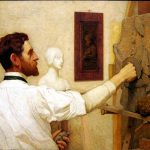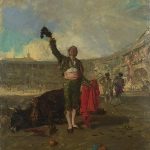Adrien Moreau, a French Academic painter born on April 6, 1843, in Troyes, France, distinguished himself as a prominent figure in the late 19th-century art scene. His artistic journey unfolded against the backdrop of significant cultural shifts and transitions in the art world. Moreau’s oeuvre, characterized by historical and genre paintings, reflects a commitment to academic traditions while navigating the evolving landscape of art during his time.
Moreau’s early artistic inclinations led him to the École des Beaux-Arts in Paris, where he studied under renowned painters, including Alexandre Cabanel. The academic training imparted a solid foundation in classical techniques and artistic principles, shaping Moreau’s approach to his craft. His dedication and talent were recognized when he was awarded the prestigious Prix de Rome in 1869.
The Prix de Rome provided Moreau with the opportunity to further his studies at the French Academy in Rome. This experience exposed him to the rich artistic heritage of Italy, allowing him to immerse himself in the works of the Old Masters and classical antiquity. The exposure profoundly influenced his artistic vision, contributing to the development of a refined and classical style.
Upon returning to France, Moreau began exhibiting at the Paris Salon, the esteemed annual art exhibition. His paintings, often inspired by historical, mythological, or genre themes, received favorable attention from both critics and the public. Notable works such as “The Death of Coligny” and “The Landing of Marie de’ Medici at Marseilles” showcased Moreau’s skill in narrative composition and his ability to convey historical events with a sense of drama.
Moreau’s artistic pursuits extended beyond historical and mythological subjects. He also explored genre scenes, capturing moments of everyday life with meticulous attention to detail. His genre paintings, exemplified by works like “The Secret” and “The First Smoke,” displayed a keen observation of human interactions and domestic settings, revealing a softer and more intimate side to his artistic repertoire.
In addition to his successes at the Salon, Moreau garnered recognition through various awards and honors, including the Legion of Honor. His reputation as a skilled academic painter solidified, placing him among the notable artists of his generation.
The late 19th century witnessed a shift in artistic paradigms with the rise of Impressionism and other avant-garde movements. However, Moreau remained steadfast in his commitment to academic traditions. His paintings, while rooted in classical techniques, revealed a sensitivity to changing tastes and a willingness to adapt within the confines of academic principles.
Adrien Moreau’s career also included teaching positions at the École des Beaux-Arts and the Académie Julian, where he shared his knowledge and expertise with aspiring artists. His role as an educator contributed to the preservation of academic traditions amidst the evolving artistic landscape.
Tragically, Adrien Moreau’s life was cut short, and he passed away on February 16, 1906, at the age of 62. Despite the challenges posed by shifting artistic currents, Moreau’s legacy endures through his contributions to academic painting. His works, characterized by technical proficiency and a commitment to storytelling, offer a glimpse into the artistic ethos of late 19th-century France, bridging the gap between classical traditions and the emerging modernist movements.






